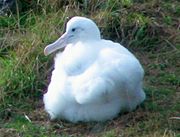Taiaroa Head
|
Taiaroa Head Māori : Pukekura |
||
 Taiaroa Head as seen from the southeast |
||
| Geographical location | ||
|
|
||
| Coordinates | 45 ° 47 ′ S , 170 ° 44 ′ E | |
| location | Dunedin , Otago , South Island | |
| Waters | Pacific Ocean | |
| Waters 2 | Otago Harbor | |
| length | 560 m | |
| width | 360 m | |
| surface | 13.6 ha | |
| height | 76 m | |
| lighthouse | Taiaroa Head Lighthouse | |
 Lighthouse on Taiaroa Head |
||
Taiaroa Head ,also known as Pukekura among the Māori , is a cape in the urban area of Dunedin on the South Island of New Zealand .
Origin of name
The cape is named after Te Matenga Taiaroa , a chief of the Iwi of the Ngāi Tahu who lived there in the 19th century.
geography
Taiaroa Head is located at the end of the Otago Peninsula and in the confluence of Otago Harbor with the Pacific Ocean , around 20 km northeast of downtown Dunedin . The closest settlement, Ōtākou , is three kilometers south of the cape.
You can reach Taiaroa Head on Harington Point Road , a coastal road that from Portobello coming, in part, to the southern shore of Otago Harbor along and to the parking lot of the visitor center on the 76 m leading high Chap.
history
Another name for the cape is Pukekura , a Pā (village) of the Māori , which was laid out on the cape and was built around 1650. It existed until the 1840s and is associated with the warrior Tarewai who lived there in the 18th century. Pilots Beach was formerly called Hobart Town Beach after the whaling station established here in 1836 by the Weller Brothers , which employed men from Hobart Town , Tasmania . Māori previously named the bay Measly Beach because it was used by them for bathing during the measles epidemic in 1835.
In 1964 the Taiaroa Head Lighthouse , which is located on the northern tip of the cape, was built. On the cape are also the remains of an earlier coastal defense, which included the position of an Armstrong Disappearing Gun , which was erected in 1886 for fear of an invasion by the Russians and can now be viewed in its restored form.
Taiaroa Head Lighthouse
The Taiaroa Head Lighthouse is the oldest operating lighthouse on the South Island of New Zealand and the second oldest in the country. The building was added to the state's Category 1 List of Appreciable Structures by the New Zealand Historic Places Trust in February 1991 .
Flora and fauna
Taiaroa Head has been designated a nature reserve and is a popular breeding site among seabirds. The Department of Conservation states that nearly 10,000 seabirds inhabit the cliffs and slopes of the Cape, including the Northern King Albatross , 200 of which breed on the Cape for most of the year, and a population of the Stewart's Shear , an endemic species of the cormorant genus that are native to the cliffs of the cape. Furthermore, can the gulls , terns , petrels and shearwaters on Taiaroa Head be observed.
On the south side of Taiaroa Head , facing the entrance to Otago Harbor , around 200 pairs of little penguins live on Pilots Beach . The total population at the Cape is estimated at around 400. Specimens of the New Zealand fur seal and New Zealand sea lions can also be found on the coast of the Cape.
Royal Albatross Center
In 1967 the Otago Peninsula Trust was founded with the aim of protecting the flora and fauna of the Otago Peninsula and promoting its development. The Trust then quickly set up an ornithological station to observe the Northern King Albatross , which settled on the Cape from around 1919 and was observed by the ornithologist Lancelot Eric Richdale from 1938 . Richdale started a campaign to protect the birds. The Richdale Albatross Observatory was opened in 1983 and the Royal Albatross Center on the Cape was inaugurated by Princess Anne in 1989 .
In 2008, the population of the northern king albatross was estimated to be around 100 birds and 10 years later it was given as around 200 specimens.
Photo gallery
Armstrong BL 6-inch Disappearing Gun on Taiaroa Head
literature
- J. Herd, GJ Griffiths : Discovering Dunedin . John McIndoe , Dunedin 1980, ISBN 0-86868-030-3 (English).
- C. Then, Neville Peat : Dunedin, North and South Otago . GP Books , Wellington 1989, ISBN 0-477-01438-0 (English).
- Peter Entwisle : Behold the Moon, the European Occupation of the Dunedin District 1770-1848 . Port Daniel Press , Dunedin 1998, ISBN 0-473-05591-0 (English).
- Pukekura ( Taiaroa Head ) Reserves Management Plan . Dunedin City Council , Dunedin March 2013 (English).
Web links
- Homepage . Royal Albatross Center,accessed September 14, 2017.
Individual evidence
- ↑ a b c d Taiaroa Head . Dunedin NZ , accessed July 8, 2018 .
- ↑ a b Topo maps . Land Information New Zealand , accessed July 8, 2018 .
- ↑ Taiaroa Head Lighthouses . Heritage New Zealand , accessed July 8, 2018 .
- ↑ a b c d Taiaroa Head Nature Reserve . Department of Conservation , accessed July 8, 2018 .
- ↑ About . Royal Albatross Center , accessed July 8, 2018 .
- ↑ Albatross colony marking 70 years . In: Otago Daily Times . Allied Press Limited , August 28, 2008, accessed July 8, 2018 .



